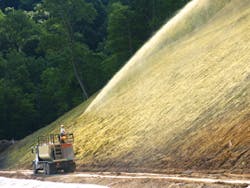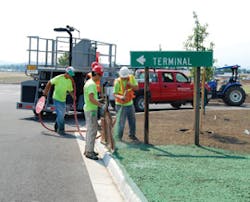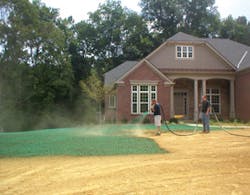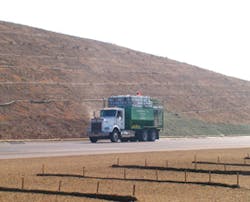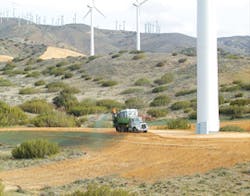Though I do not believe that a plant will spring up where no seed has been, I have great faith in a seed.
-Henry David Thoreau
The opportunity to be creative, to solve one’s problems, to see a job from start to finish, and, especially, to control one’s environment, are all factors in job satisfaction. If the following sample is any indication, that satisfaction is commonly found behind a seeding machine.
Despite such challenges as rough and twisty terrain, mucky soil, and ever-capricious weather patterns, those who plant seeds are their own bosses and take satisfaction in a task completed.
Third-Generation Hydroseeders
Bill Law is the owner of Law’s Inc., formerly Law’s Nursery and Garden Center, in Lisbon Falls, ME. “My grandparents came up here from Connecticut in the ’50s,” he says. “When [the state of Maine] built the interstate, my family took their seeding machines from Kittery to Houlton.”
Seeding at Medford International Airport
The Maine Turnpike, begun in 1947, was the first superhighway built in the postwar era and one of only two modern toll highways in existence in the United States. (The Pennsylvania Turnpike opened in 1940.) It had four lanes and a wide, grass median, an innovative safety feature at the time.
Law is a third-generation seeder and hopes his son will follow in the family profession. “But I don’t think so; he’s 17 and he wants to make money.”
In Maine, where snow can fall on Halloween, getting the ground seeded before winter sets in is a major priority. “I like to be finished by mid-October,” Law says. “I usually can convince private owners to wait until spring, but sometimes the state has a project that has to be done, and we have to seed on snow.” When snow is an issue, Law says that the best answer is to put on hay and tackifier and wait until spring to put down seed.
In late September, just after Hurricane Kyle had shunned Maine, making way for another storm system to dump 5 inches of rain on the region, Law was seeding 14 acres in the Ellsworth area. “They’re putting in one of those big stores, Home Depot or Wal-Mart, and we’re getting the area ready for winter.”
Law was using Reinco’s 3,500-gallon Hydrograsser and the M-90 Power Mulcher. “It’s geared up to do big areas,” he says of the Hydrograsser, adding that the machine, mounted on a truck, can cover up to 2 acres at a time.
The rain was making the ground “mucky,” and a bulldozer was towing Law’s machine. “We’d probably like to wait and do this later,” he says, “but the client is on a time schedule.”
John K. Leohner II and his sister Kendra Riggs are the third generation of Leohners in the landscaping business. The Columbus, OH-area company, which bears his name, does grass seeding and erosion control work, typically as a subcontractor.
In early October 2008, Leohner was seeding a section of State Route 161/37 for Shelly and Sands Construction under the direction of the Ohio department of transportation. The entire $200 million road project includes widening a 12.8-mile stretch from New Albany to Granville from a two-lane road to a four-lane highway. Interchanges will replace several intersections, decreasing drive time on the new limited-access route. “We’re hydroseeding the medians, roadsides, and bridge slopes,” Leohner says.
For jobs like this one, Leohner has come to depend on his Finn machines, which he claims are more reliable than other machines he has used in the past. “We have three T- 330 seeders, three B-260 mulchers, a T-250 seeder, and a T-150 seeder.”
For the highway project, Leohner used the T-330 mounted on a Ford Aeromax 9000 to seed, fertilize, and spray Finn’s HydroStik, a gum-based tackifier. “After prepping the surface, we seed in 6-acre batches, then use the B-260 Straw Blower, which blows 12 tons in two and a half hours.”
When the Rome-Hilliard Road on the west side of Columbus, OH, expanded from two to five lanes to accommodate increased housing in the area, Leohner mulched with a 200-foot hose reel in order to access areas like sidewalks that were 5 feet wide and 1,000 feet long. “We sprayed in half-acre batches through hose reels,” he says.
Athens, OH, is nestled deep in the Appalachian foothills of southeast Ohio. Another of Leohner’s projects was the Athens-Darwin Connector on SR 33. “We used both [of the above] procedures on that one,” Leohner says. “For the unreachable areas, like slopes with 3-to-1 cuts, we hooked up a dozer to drag our truck up and down the hills. That truck weighs up to 60,000 pounds when it’s loaded; the dozer would let us down the hill and drag us back up again.”
But Leohner’s most unusual seeding experience came at Buckeye Lake in Millersport. Constructed as a canal feeder lake in 1826, the lake is Ohio’s oldest state park, offering swimming, skiing, boating, and fishing in an area that is otherwise landlocked.
“We were landscaping on a 1.5-acre island in the lake, so we put the seeder on a barge, rolled out extension hoses, and threw them onto the island. We sprayed the whole area from the barge without having to move the truck.”
Surfing and Seeding in the Northwest
While some entrepreneurs are following a family tradition, others are just having their own good time. And no one is having more fun than Todd Kaberline. This owner of Canyon Crest Landscaping in Medford, OR, has an enviable existence. He can stand among the redwoods near his home in the morning, and, in one hour, be surfing in the Pacific. When he’s not surfing, he can concentrate on being a union landscape contractor for parks and public works.
Kaberline waxes poetic about Oregon, but he is equally effusive in his praise of his 1,200-gallon hydroseeding machine from Kincaid Equipment Manufacturing. “If after 30 years in the business I had the equipment to design a hydroseeding machine in my own shop, this is the one I would build.”
Although he has had the machine less than a year, Kaberline says its competitors simply cannot compete. “When I call the company, I can get a person right away and talk to the people who built and designed my machine. The direct contact has really impressed me.”
Kaberline says he was looking online when he found his hydroseeding machine; he found one that had been returned, so he saved money. “If I had to do it again, I’d do it twice.”
Canyon Crest’s typical job is about 5 acres, but he has seeded up to 60 acres. He says the machine has great ease of access and can handle a heavy load of slurry. “I experiment a lot. For one job in a wetland, I took stolons from wetland plants, chopped them up, and put them in the mix. I planted in a really rocky area, and they took off like crazy. Another machine might have not spit them out.”
Kaberline likes the 3-inch-diameter pump on his Kincaid. “It doesn’t have a lot of bends in it; those cause clogs.”
The machine will take up to 12 bales of wood fiber, enough to cover 1,200 to 1,500 square feet. At one-fourth to one-third an acre each, he can cover five acres a day.
Canyon Crest recently did a job for Medford International Airport. “We did erosion control, bioswales, and large lawn areas. It took six months to complete.”
For what he calls the nicest sports center in the Northwest, US Cellular, Kaberline is currently seeding, planting, and irrigating 40 acres of athletic fields, also in Medford.
Challenging Conditions
But riding on a seeding machine isn’t just fun and games. There are all kinds of challenges, from weather to terrain. Just ask Kent McLain, operation manager for M & M Pipeline in Mathiston, MS. “If it was easy, everyone would do it,” he says about following a gas pipeline right of way on a hydromulcher pulled by a four-wheel farm tractor. “It isn’t at all like sowing seed in a pasture. We have to go up hills, down valleys, sideways, up and down creeks, over railways and highways. These are extremely rural areas, and if you don’t blanket them well, the first good rain will take it all away.”
McLain’s recent stint involved seeding a line from Vicksburg, MS, to Mobile, AL, a job that lasted from January
Hydroseeding on a residential lot
to September and covered 250 miles. “We average about a mile a day,” he says.
The choice of equipment depends on location. “We use no-till drills and then mulch them with round and square bale processors,” McLain says. “We hydroseed if we are working inside a compression and meter station with aboveground pipe. We use round-bale mulchers 90% of the time; otherwise we use the square-bale mulcher. The machine just mulches, sprays a blanket of straw, and crimps the straw.”
M & M Pipeline uses DuraTech products for its jobs. For seeding, DuraTech offers two drills: the 77 and the 107, both of which have two seed boxes and optional legume box, as well as native grass attachments. The Haybuster drills can also be used for crimping in highly erodable areas, such as pipeline rights of ways. The 254 Balebuster with blower can blow straw and mulch out to 100 feet.
Even when the place is easy to get to, that doesn’t mean the ground is solid enough to support a heavy piece of equipment.
After days of rain, Cory Streblow, owner of Pacific Rim Hydroseeding Inc. in Valley Center, CA, had to seed a new golf course in Matthews, LA, that had been built over a swamp. “The course is only about 5 feet above sea level,” he says. “We used the Bowie 1100, but the ground was so soft that we couldn’t move the machine when it was loaded. We would pull the empty seeder out to the fairway, load it off the irrigation heads, spray, and move it again when it was empty.”
Streblow, whose company works on residential and commercial projects, owns both the Bowie 1100 Vector and the 3000 Imperial machines. He sprayed the fairways with 419 Bermuda grass and stolons and put native mixes on the fringes. Covering 55 acres at about 2 acres a day, the job took about a month.
Many of us think of the Civil War as strictly an Eastern seaboard affair, but Californians actually provided 15,725 volunteers to the Union Armies. They served on the East Coast and in other states’ units, helping to secure the Pacific coast and keep the Confederates in Texas from spreading farther west.
At Evergreen Memorial Park Cemetery in Riverside, CA, there is a marker inscribed “G. A. R. To The UNKNOWN DEAD Who Gave Their Lives For The Union From 1861-1865 W. R. C.”
As part of a project to restore the cemetery, which has been rundown and subject to vandalism, Mark Odell’s Riverside company, Canyon Hydroseeding, reseeded the area of the cemetery where the Civil War veterans are buried. The project, which took less than two days in August, was sponsored by donations from prominent people in the area, according to Odell.
Access proved to be a problem for one simple reason, he says. “You can’t drive over the graves. We used quite a bit of hose.”
A huge fan of his Kincaid Pro Series 1200 G2C Vortex Diesel, purchased in November 2007, Odell says that after 30 years of using other brands, he would never go back. “It has a lot of different features: a large [98-horsepower] Kubota engine, an oversize pump with better pumping capabilities, and all the hydraulics.”
Spraying the sides of the road on Route 125 near Chula Vista, CA
Odell says his crew was able to seed 3 to 4 acres a day and finish the 5-acre job in just under two days. Using paddle agitation and a slurry mix of wood fiber, hybrid Bermuda grass, fertilizers, and tackifier, they were able to set the foundation for a refurbished area of lawn that would lend dignity to the old burying ground.
What’s This Mountain Doing in My Way?
Phil Richter, owner of Richter Landscape in Hood River, OR, recently used his Kincaid 1200 on a 2-acre landscaping job on the upper hills of the Columbia River Gorge, a river canyon cutting the only sea-level route through the Cascade Mountain Range. It is 80 miles long and up to 4,000 feet deep, with the north canyon walls in Washington and the south canyon walls in Oregon.
“They were putting in a huge sewer, and there was no access to the slopes,” Richter says. “We pumped and pumped with 400 feet of hose from six different locations at the bottom.”
Richter praises the Kincaid’s versatility. He owns the Kincaid Pro Series 1200 and declares it a midsize machine big enough for any job. “It’s a diverse multitasker that works for any job, big or small. I can mix any kind of mulch or seed and spray it from a gun-mounted cannon on the top or shoot over the edges or pull out and connect several hoses to get fine finishes to hard-to-reach areas.”
When the mountainside makes its own way down the mountain, the job gets even harder. A mudslide on January 19, 2008, damaged the Union Pacific Railroad’s main line track south of Eugene, OR, and closed the railway just east of Oakridge. The slide had two parts: an upper 20 acres where the failure originated and a 40-acre path made by debris as the slide made its way down the mountain.
Beginning in June 2008, it was the task of NorthWest Hydro-Mulchers of Boring, OR, to revegetate the area as
Revegetating near a southern California wind farm
tracks were being replaced. “We used 20 acres of Flexterra on the slide portion. All of the area was overburdened where the soils had trekked through,” says owner Barry Cook. “We seeded with HydroStraw and [Rantec Corporation’s] Super Tack and created another 40 acres so that trucks could get into the spoil sites. Thirty to 40 miles of road needed improvement to withstand earthmovers and truck traffic.”
For the project, Cook says his company used three different Finn HydroSeeders-the T-330, the T-170, and the new Titan-as well as Bowie’s Victor 1100 gooseneck, which, according to its manufacturer, makes hauling and maneuvering much easier, and provides additional area for hauling the product to be sprayed. “These were all dragged up and staged on the massive slide,” Cook says, adding that two 20,000-gallon tanks were placed on the slide face and fed out of a 4-inch line.
Access was a problem, Cook says. “The water source was 2,000 feet away, and it was almost a continual run from the source to fill the tanks. We put in a series of 3-inch trash pumps to feed the HydroSeeders placed at various points with 900 feet of 3-inch hose. We had to do the bulk of it with hoses.”
Crews did all the roadside work with the Flexterra application and then reseeded the cut-and-fill slopes. “The products we used combined to provide excellent erosion protection and excellent vegetation establishment. Germination occurred in approximately three weeks,” Cook says.
The advantage of Super Tack, according to Cook, is that it disperses easily in water. “The loading sequence is tackifier, mulch, seed, and fertilizer, with water as the carrying agent.”
Waiting for the Houses
San Diego’s Regional Water Quality Control Board has some of the strictest standards in the nation, according to Rob McGann, who works as an estimator, coordinator, and purchasing agent for Hydro-Plant Inc., in San Marcos, CA. With a population of nearly 3 million and proximity to the Pacific Ocean, San Diego County faces challenges of constant construction, and the need to keep construction sediment out of the waterways.
While Hydro-Plant has recently been heavily involved in reclaiming areas disturbed by summer fires, it also performs commercial and residential work. “We have been in conversation with builders who need us to prep the soil for winter,” McGann says. “It gets very dry in California, and when we do get storms, there is a tremendous amount of rain in a short time. And that leads to sediment runoff.”
Recently, Hydro-Plant stabilized the pads and slopes for McMillin Homes, one of the largest builders in San Diego and Central Valley. A pad can run anywhere in size from 5,000 to 50,000 square feet, and “super pads,” where several structures share the same base, are common.
The magic bullet in any application intended to last is tackifier, McGann says. Hydro-Plant uses Rantec’s guar-based Super Tack. “It’s cheaper than the others, it’s effective, and it’s basic. You always need tack, unless it’s a non-eroding landscape.”
To apply the mulch, Hydro-Plant uses its five 3000-series Bowie machines. “Our owner has been doing this for 35 years, and he’s always used Bowie,” McGann says. “We also have a couple trailer-mount 6000 and 750 Finns for smaller jobs.”
For winterizing pads to withstand erosion, the company generally uses 2,000 pounds of fiber to 100 pounds of guar. “If the project is near the water, we increase the amount to 3,300 pounds fiber to 200 or 250 of guar,” McGann says. “That really buttons things up.”
The longevity of the heavier application is nine months, as opposed to three months for a lighter spray, McGann says. Hydro-Plant’s job is to protect the soil until building occurs, and this can take a while. “Sometimes we apply the hydromulch during one season and the water-quality agency has us reapply the next season if no landscaping has taken place. Often, in production homes, the infrastructure is in, but there’s no home yet.”
Staying Ahead of the Governor
Leo Brendis is the owner of Hydrosprout Inc. in Escondido, CA. In business for 21 years, the company has always used Bowie equipment.
Starting with a small, 800-gallon machine towed behind a truck, Brendis increased the size and number of his machines. Seven of them are the Imperial 3000 Hydro-Mulchers, with a 3,171-gallon capacity. “We do everything,” Brendis says. “Highways, dams, pipelines, parks, schools, development sites. From big to small, from landscape contractor to homeowner.”
A recent project involved spraying the sides of the road on the southern portion of Route 125 from Route 905 to Route 54 near Chula Vista, which is a toll road called the South Bay Expressway. “The soils had been disturbed, so we revegetated with natural grasses and ornamental landscape materials.”
The entire project took four years. It was necessary to apply a temporary spray to hold the soil until it was ready for irrigation. “All the disturbed soil had to be hydromulched and had to meet stormwater compliance for disturbed soil,” he notes. Near the end of the project, “the governor [Arnold Schwarzenegger] was flying in to open the highway, so we worked six trucks seven days a week, 12 to 15 hours a day, from sun up to sundown until it was finished,” Brendis says.
While Brendis used the larger machines for the highway project, he used Bowie’s Victor 1100 to revegetate areas disturbed by the recent California fires. “You can’t get vehicles in; we had to pump up the side of mountains.”
Seeding in Bermuda
For the very lucky, seeding comes with a tropical vacation. Paul Bradley, owner of Allied Pacific, has offices in St. George and south Salt Lake City, UT, as well as the Las Vegas area. “Four years ago, St. George was the fastest-growing small city in the nation, and Las Vegas was the fastest-growing large city,” he says, explaining why he moved his 10-year-old company to the mainland from Honolulu. But he still travels to the Hawaiian Islands, Guam, and Micronesia, and he recently went to Bermuda to take on landscaping projects.
The Port Royal Golf Course in Southampton, Bermuda, designed by world-renowned architect Robert Trent Jones, Sr., opened for play in 1970. In January 2008, the government closed the course for a major renovation of the tees, fairways, bunkers, and greens. The layout was lengthened by 196 yards.
Part of the project involved reseeding the greens and fairways, as well as the peripheral areas of the course. An effort was made, however, to keep the existing trees and to change the layout only minimally. “It has all the nostalgia of an old golf course,” Bradley says.
Completed in October 2008, the restoration of the course-which was “turfed and shaped to current USGA specifications” and kept most of its original design, according to Bradley-took 10 months. The reseeding involved 82 acres, about 3 acres a day. “It wasn’t like a new course; we had to work around the trees.”
Bradley says he used Bowie’s Victor 1100 to apply cuttings of Bermuda grass, with the smaller model making access easier than the larger model. “I’ve always used Bowie; the productivity is two and a half times greater than the competitors’ machines. Why would anyone buy a different brand?”